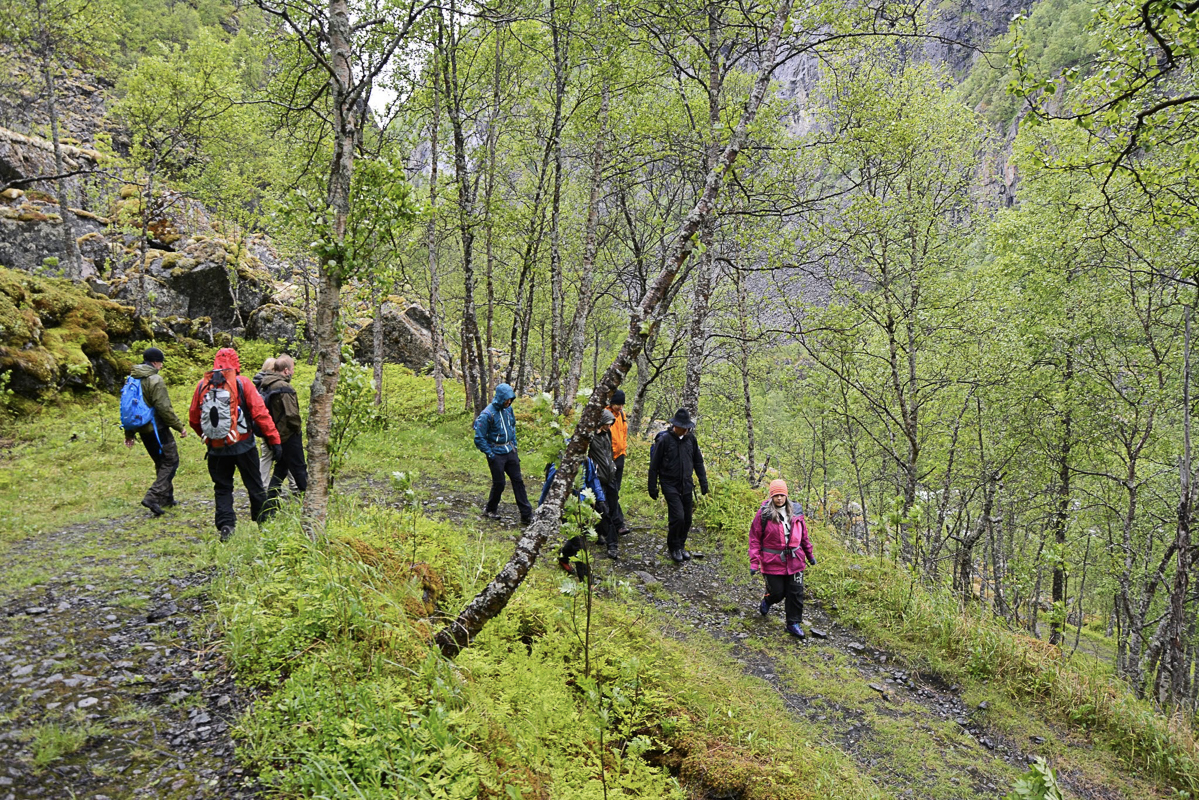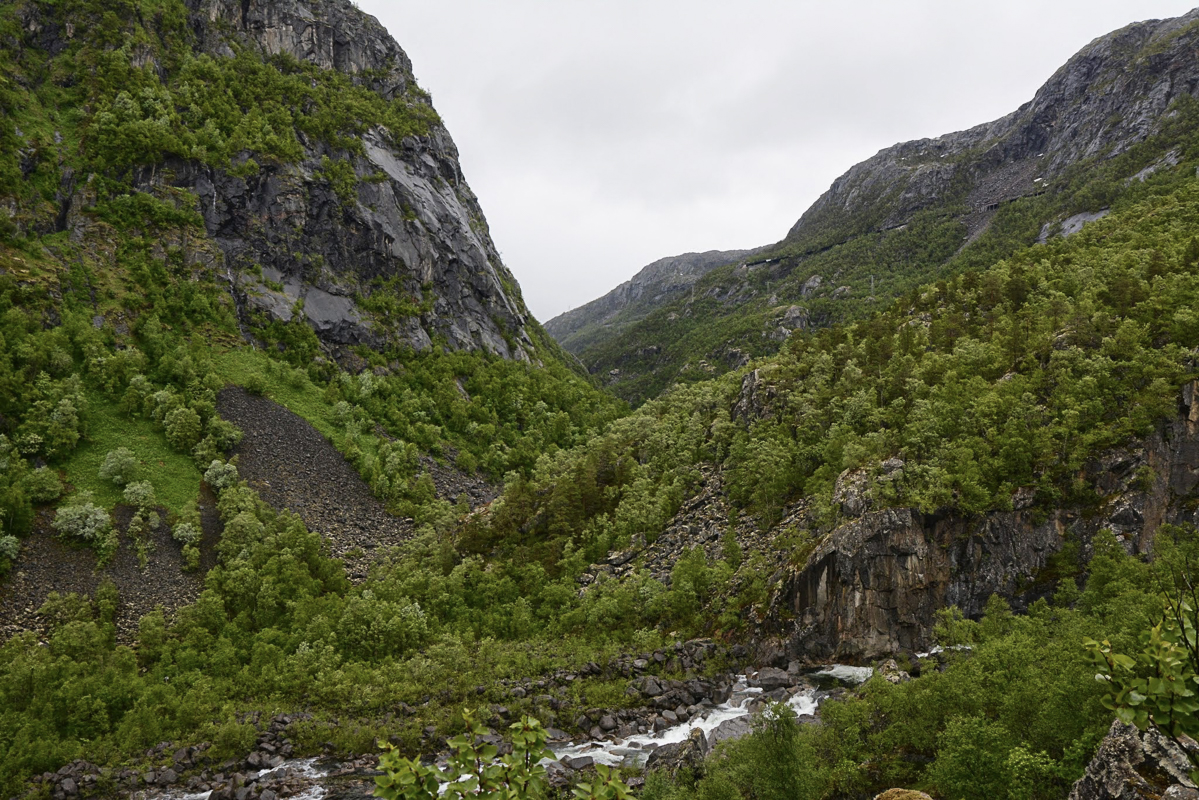Imagine an easy ramble through a magnificent, untouched landscape of mountains, dales and waterfalls. Add a large helping of cultural history and a melodrama of unhappy love, and you have the Rallarveien trail near Narvik.
Rallarveien (“The Navvy Road”) was not built for tourists to walk or cycle, but was the main traffic artery for transporting people and materials during the construction of the Ofotbanen railway. The railway was built in two stages: an English company began by laying track from Narvik to Katterat during the period 1885-89, but the company went bust; then work started up again in 1898, and the entire railway was completed in 1902. During these two periods the area was invaded by migrant labourers or “navvies” (“rallare”), who formed entire communities around the building of the railway. In 1902, they packed up and left.
A red railway station marks the start of the trail
The smart, red-painted railway station at Katterat is surrounded by several houses from the time when it was a little station town for railway employees and their families, 30-40 people in all. There are even lawns and flowers – aesthetics and public enlightenment were important when building railway stations in days gone by. Now the old houses are used as holiday homes. Katterat was closed down when automatically controlled points systems were introduced on the railways in the 1960s, but the station has since been preserved for posterity.
You will walk right out into the valley
Hundalen (“hun” means bear cub) is an unpopulated, beautiful valley wilderness lying between the Swedish border and Rombaksbotn, and surrounded by enormous mountains and snow-clad peaks. The Ofotbanen railway runs high up along the southern side of the valley, but the sound you can hear is that of rushing waterfalls. The pale, quivering silver birch forests up at Katterat grow denser as the train descends into the valley, with the hillsides clad in aspen, pine and rowan, and the forest floor covered with ferns and wild flowers.
Among the forest lies hidden architectural secrets
You will encounter traces of the navvies who built the railway along the entire line. Directly below Katterat are the remains of buildings from the very earliest days of railway construction. Close by are also the remains of an electricity sub station used to power the new pneumatic drills that were tried out here for tunnelling. On the other side of the river you can glimpse a mast that was part of the aerial ropeway used to transport construction materials. Old raspberry thickets, red currant bushes and rosebay willow herb also testify to human activity.
Eat where the Brandy King had a cafe
By the Storfossen waterfall there is a large rock, the erstwhile fourth wall of a long-gone, simple hut from which a man known as “Konjakk-Nisse” (“Brandy-Nick”) ran a café in the railway-building era. Alcohol was prohibited in the works area, but Konjakk-Nisse knew how to fool the police, taking payment in the form of pawned wedding rings and pocket watches. When the railway was nearly finished, he came storming in to the works one day, frantically yelling that his wife had left him, taking all the valuables the navvies had pawned. Rumour has it, though, that the couple were later seen together at the Ølhallen beer hall in Tromsø!
Svarta Bjørn is a legend along the Rallarveien
One of the legends along the railway is that of Svarta Bjørn (“Black Bear”), a navvy camp cook whose real name may have been Anna Rebekka Hofstad. She got her nickname from a local Sami who noticed her big, strong figure and dark hair. There are many and conflicting stories about her, but wilful and passionate as she was, it seems she got herself mixed up in a drama of jealousy and unhappy love. She died either of tuberculosis or as a result of a fight with another cook over the same man. A wooden cross with the inscription «Anna, Norge» (“Anna, Norway”) marks her grave in the navvies’ church yard in Tornehamn on the Swedish side of the border. Since both her identity and what actually happened to her are very unclear, myths about her have grown up in literature, in folk songs and in films.
The sister streams cascade through the forest and end by the fjords
While you wander among the silver birches down in the valley, you will see two stripes up among the treetops, which are the two Søsterbekkene (“Sister Streams”). Plunging in wild cascades and rapids down the valley side, the streams eventually meet and flow in unison under the footbridge you’re about to cross. According to tradition, anyone who buys a new navvy hat has to christen it in the streams. If you walk up to the top of the hill below the path, you can see over the flat valley floor, which suffered very serious flooding in 1959.
Rombaksbotn was once a hive of activity, but now lies amongst nature
Almost right down by the fjord lie the remains of the old navvies’ settlement. During the years while the railway was being built there lived about 500 people here, with an entire small “town” with shops, barbers’ shops, a skittles alley, a soft drinks factory, hotels and several licensed premises. At «Jokkenborg», services could also be obtained of a more intimate nature… When the railway was finished, the wooden buildings were taken down and moved, and can be found over the whole of Ofoten. You will need the help of the excellent information boards along the path to see the town in your mind’s eye, for Mother Nature has re-conquered Rombaksbotn.
Rallarveien is an easy hike to take
We chose the simplest solution, namely to take the train up to Katterat station and then walk the 6 kilometres (3.7 miles) down to Rombaksbotn, from where we caught a ferry back to Narvik. It is also possible to get off the train at Bjørnfjell station, which shortens the walk to 13 kilometres (8 miles), all of it downhill. The path is relatively well-kept, with stone paving and steps, and is manageable by all able-bodied walkers. And, as it’s downhill all the way, there is no exertion involved. There are plenty of benches and campfire areas along the path. The most impressive thing, however, are the many information boards, providing in text and black-and-white photographs hard facts as well some of the legends that have grown up around Rallarvegen. Visit www.destinasjonnarvik.no for all the practical information you need.




